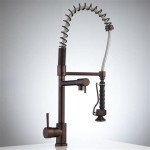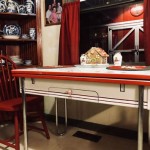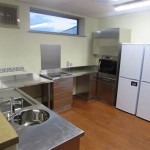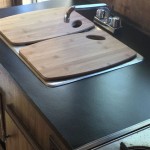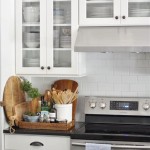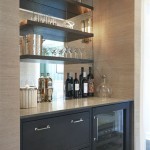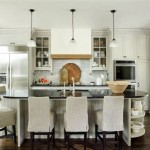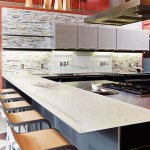Creating an Eye-Catching Black and White Kitchen Floor Plan
A black and white kitchen floor plan offers a timeless aesthetic, providing a classic yet versatile foundation for a range of design styles. From minimalist modern to vintage farmhouse, the monochromatic palette allows for flexibility in accessorizing and updating the overall look. Successfully implementing this design relies on careful planning and attention to detail, considering factors such as pattern, material, and the interplay of light.
The enduring popularity of black and white kitchens stems from their inherent ability to create a striking visual impact. The contrast between the two colors immediately draws the eye, creating a sense of drama and sophistication. Moreover, this color scheme serves as a blank canvas, allowing homeowners to incorporate personal touches through artwork, appliances, and decorative elements without overwhelming the space. However, the success of a black and white kitchen floor plan hinges on several key elements, including layout optimization, material selection, and a balanced approach to color distribution.
Optimizing the Kitchen Layout
Before embarking on the selection of materials and color schemes, a well-defined kitchen layout is paramount. This involves considering the available space, the desired workflow, and the placement of essential appliances. A standard layout typically incorporates the "work triangle," connecting the sink, refrigerator, and cooktop or oven. This arrangement aims to minimize movement and maximize efficiency during food preparation.
Various kitchen layouts can be adapted to a black and white scheme. A galley kitchen, characterized by two parallel counters, benefits from strategic color placement. Using white cabinets on the upper level can visually expand the space and enhance brightness, while black lower cabinets provide a grounding effect. In larger kitchens, an island can serve as a focal point, potentially featuring a contrasting color or material to break up the monotony. Consider the positioning of the island to ensure adequate circulation and functionality.
When planning the layout, account for storage requirements. Incorporating features such as pull-out shelves, drawer organizers, and vertical storage solutions can maximize space utilization and minimize clutter. The choice of cabinet hardware can also contribute to the overall aesthetic. Chrome or stainless steel handles and knobs offer a modern touch, while black or brass hardware can evoke a more traditional or industrial feel.
Lighting plays a crucial role in any kitchen design, but it is especially important in a black and white scheme. Adequate lighting is essential to prevent the space from feeling dark or gloomy. A combination of ambient, task, and accent lighting can create a layered and inviting atmosphere. Recessed lighting provides general illumination, while under-cabinet lighting illuminates countertops and work surfaces. Pendant lights over the island or dining area can add visual interest and serve as decorative elements. Natural light should be maximized, if possible, through the use of large windows or skylights.
Selecting Appropriate Materials
The choice of materials significantly impacts the overall look and feel of a black and white kitchen. Different materials offer varying textures, finishes, and durability levels, all of which contribute to the design's success. For flooring, options include tile, hardwood, vinyl, and concrete.
Tile is a popular choice due to its durability, water resistance, and wide range of design possibilities. Black and white tile patterns, such as checkerboard, herringbone, or geometric designs, can add visual interest and create a focal point. Consider the size and shape of the tiles to achieve the desired effect. Larger tiles can create a more modern and seamless look, while smaller tiles can add a touch of vintage charm. The grout color also plays a role; a light grout can emphasize the tile pattern, while a dark grout can create a more subtle and unified appearance.
Hardwood flooring offers a warmer and more traditional aesthetic. Dark-stained hardwood can complement black cabinets, while lighter-stained hardwood can provide a contrast and brighten the space. Ensure that the hardwood is properly sealed and protected from moisture to prevent damage. Consider using engineered hardwood, which is more resistant to warping and moisture than solid hardwood.
Vinyl flooring is a cost-effective and durable option that mimics the look of tile or hardwood. It is also water-resistant and easy to clean, making it a practical choice for kitchens. Vinyl flooring is available in a wide range of patterns and colors, allowing for creative design possibilities. Luxury vinyl tile (LVT) offers a more upscale look and feel compared to traditional vinyl flooring.
Concrete flooring provides a sleek and modern aesthetic. It can be stained or polished to achieve a variety of finishes and colors. Concrete is durable and easy to maintain, but it can be cold and hard underfoot. Consider adding rugs or mats to provide warmth and comfort. Sealed concrete is essential to prevent staining and damage.
For countertops, options include granite, quartz, marble, and concrete. Granite and quartz are durable and resistant to scratches and stains, making them practical choices for busy kitchens. Marble offers a luxurious and elegant aesthetic, but it is more porous and prone to staining. Concrete countertops can be custom-made to any shape or size, but they require proper sealing and maintenance.
Cabinet materials should also be carefully considered. Painted wood cabinets offer a classic and versatile look, while laminate cabinets provide a more budget-friendly option. Stainless steel cabinets offer a modern and industrial aesthetic. Consider the durability and maintenance requirements of each material when making your selection.
Balancing Color Distribution and Accents
Achieving a harmonious balance between black and white is crucial for a successful kitchen design. An even split between the two colors can sometimes feel static and uninspired. A more dynamic approach involves using one color as the dominant hue and the other as an accent. For example, a primarily white kitchen with black accents can feel bright and airy, while a primarily black kitchen with white accents can feel dramatic and sophisticated.
Consider the existing architectural features of the kitchen when planning the color distribution. If the kitchen has large windows or a skylight, using white as the dominant color can maximize the natural light and create a brighter space. If the kitchen has limited natural light, using black as an accent can create a cozier and more intimate atmosphere.
The backsplash provides an opportunity to introduce pattern and texture. A black and white backsplash can serve as a focal point, adding visual interest to the kitchen. Options include subway tiles, mosaic tiles, or patterned tiles. Consider the scale of the pattern to ensure that it complements the overall design. A smaller pattern can create a more subtle effect, while a larger pattern can create a bolder statement.
Appliances play a significant role in the overall aesthetic of the kitchen. Stainless steel appliances are a popular choice, offering a modern and sleek look. Black appliances can create a more cohesive and dramatic feel, while white appliances can blend seamlessly with white cabinets. Consider the finish of the appliances to ensure that they complement the other materials in the kitchen.
Accessories and decorative elements provide the finishing touches to the design. Consider incorporating pops of color through artwork, dishware, or textiles. A vibrant rug or a colorful vase can add personality and prevent the kitchen from feeling too sterile. Plants can also add life and freshness to the space. Choose accessories that complement the overall style of the kitchen while reflecting your personal taste.
Hardware and fixtures like faucets and lighting can be used as accent pieces. Selecting contrasting metals such as brass or stainless steel can draw attention and create a focal point. The choice of lighting fixture styles can also significantly affect the overall aesthetic. Modern pendants, vintage chandeliers or recessed lighting each provide a unique characteristic to the design. The combination of these elements is essential in tying the kitchen together to create an impressive visual style.
Careful planning and execution are essential for creating an eye-catching black and white kitchen floor plan. By optimizing the layout, selecting appropriate materials, and balancing color distribution, homeowners can achieve a timeless and stylish kitchen that reflects their personal aesthetic. The versatility of this color scheme allows for endless possibilities, making it a popular choice for both modern and traditional homes.

18 Black And White Kitchen Ideas From Modern To Farmhouse

Kitchen Floor Plan Guide Layouts Tools Designs Tips

30 Black And White Kitchen Ideas That Will Make You Want To Redecorate Now The Crafty S

Black Kitchens Bold Design Ideas To Transform Your Space Decorilla Interior

37 Gorgeous Ideas For The Perfect Black And White Kitchen

The Timeless Appeal Of Monochromatic Kitchens Dreammaker

12 Black And White Kitchens That Serve Up Timeless Glamour Architectural Digest

How To Design A Classic Black And White Kitchen Wren Kitchens

Black Kitchens Bold Design Ideas To Transform Your Space Decorilla Interior

37 Gorgeous Ideas For The Perfect Black And White Kitchen
Related Posts

